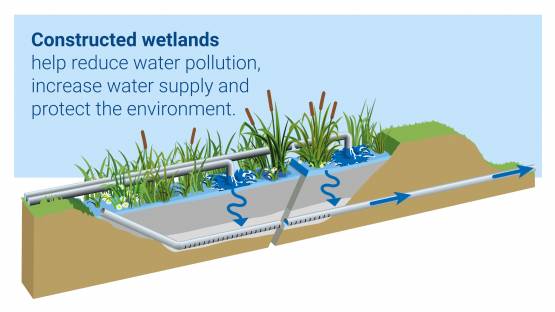The IAEA is inviting research institutions to join its new five-year coordinated research project (CRP) on developing radiometric methods for measuring hydrodynamics of constructed wetlands.
Constructed wetlands (CWs) are engineered systems, designed to utilize the natural functions of wetland vegetation, soils and their microbial populations to treat contaminants in surface water, groundwater or waste streams. They have evolved over the last five decades into a reliable treatment technology applicable to all types of wastewater, including sewage, industrial and agricultural wastewaters, landfill leachate and stormwater runoff.
Unlike in natural wetlands, where pollution is removed through natural processes, in CWs such processes proceed under controlled conditions. CWs thus help reduce water pollution, increase water supply and protect the environment, contributing to the achievement of the United Nations Sustainable Development Goals (SDGs).
Despite their advantages over conventional wastewater treatment plants, mainly the green technology they offer, inadequate knowledge and understanding of their complex hydrodynamics makes efficient operation and optimization of CWs challenging. The hydrodynamics in a CW depend on its shape, temperature, and the physical properties of the wastewater, as well as the porous sediment, where most of the microbial activity takes place. Conventional tracers including fluorescent tracers are not suitable for hydrodynamic measurements in CWs mainly due to the size and the long mean residence times of such artificial wetlands. Hence, employing radioactive tracers holds promise in measuring CW hydrodynamics to provide important data towards properly understanding constructed wetlands and consequently optimizing their operation.
CRP Objectives
Running from 2023 through 2027, the overall objective of this CRP is to develop radioactive tracer methodologies for hydrodynamics studies of CWs. The ultimate goal is to improve the design and management of CWs and their integration into related wastewater treatment facilities.
Specific objectives are:
- To develop a radiotracer methodology for CW studies and establish protocols and guidelines for the methodology
- To develop flow models (Computational fluid dynamic (CFD), mathematical models and compartment models) for CWs
- To validate the developed models using data from radiotracer studies
How to join the CRP
Research organizations interested in joining the CRP must submit their Proposals for Research Contract or Agreement by email, not later than 15 February 2023, to the IAEA’s Research Contracts Administration Section, using the appropriate template on the CRA web site. The IAEA encourages research organizations, to involve, to the extent possible, female researchers and young researchers in their proposals.
For further information related to this CRP, potential applicants should use the contact form under the CRP page.




